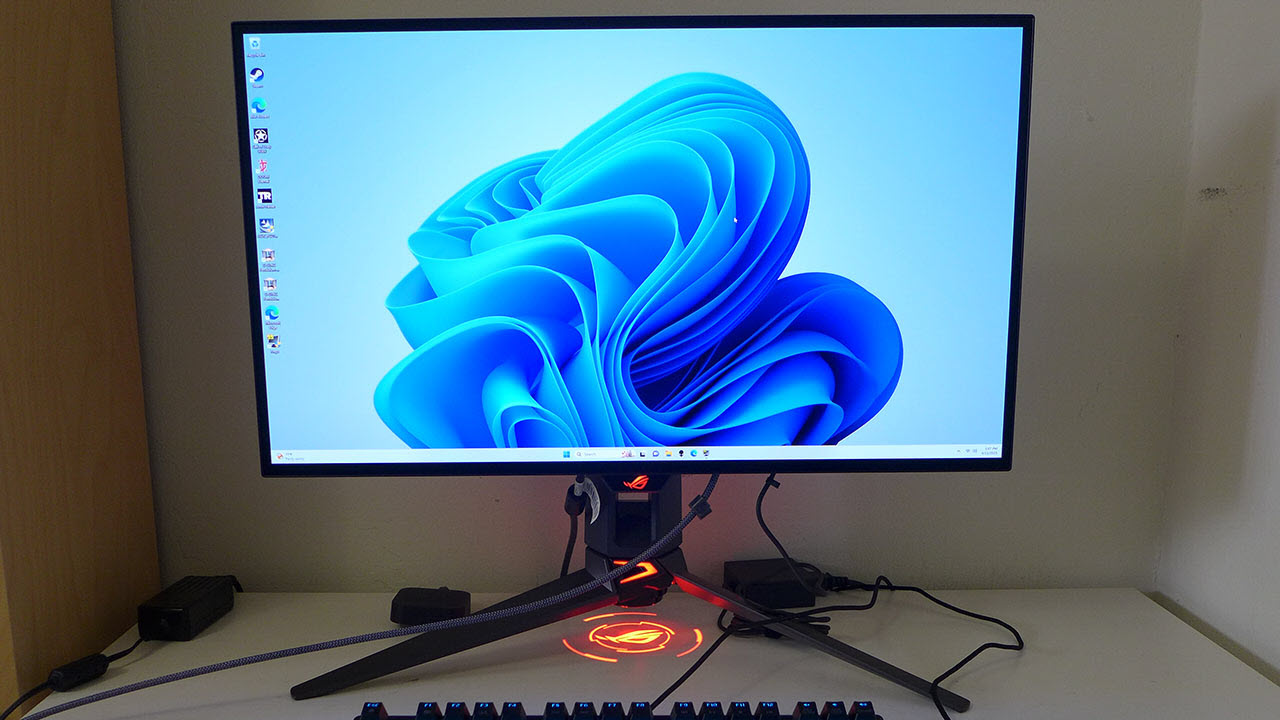
There are many good gaming monitors available in all sizes, shapes, and budgets. But only a handful can be called great. What does it take for a display to make this list? Speed is certainly a huge factor; you can’t throw a rock without hitting a monitor that runs at a minimum of 144 Hz. 165 Hz is becoming more common, and 240 Hz is well represented. The bleeding edge is occupied by 360 Hz and now 500 Hz screens.
If you’ve read monitor reviews here at Tom’s Hardware, you know that we consider image fidelity a nearly equal part of the equation, and at the top of that list is contrast. Nothing affects our perception of a 2D image more than the difference between black and white. Lately, Mini LED panels have made huge strides in this area, and I’ve even called them “nearly as good as OLED.” But the operative word is “nearly.” OLED is still king, and in this review, I’ll be testing a 27-inch 16:9 OLED display, Asus ROG Swift PG27AQDM. Spoiler alert: it’s incredible in pretty much every way, which makes it a prime candidate for our best gaming monitors list.
Asus ROG Swift PG27AQDM Specs
The PG27AQDM starts with an OLED panel made by AU Optronics. It’s my first time testing an OLED not made by LG Display. The viewable area is 26.5 inches, so with QHD (2560x1440) resolution, we get a pixel density of 111ppi. That’s important because nearly all OLEDs today are UHD (3840x2160). However, the larger screens don’t necessarily have sharper images. Consider that a 42-inch OLED panel like Asus’ own PG42UQ has a density of 105ppi.
With QHD resolution comes higher frame rates, and the PG27AQDM offers a maximum refresh rate of 240 Hz with a claimed 0.03ms response time. I found it quicker than any other 240 Hz monitor during testing. In fact, it matches the total lag time I’ve measured for a typical 360 Hz screen and is only a few milliseconds behind the Alienware AW2524H 500 Hz display. It achieves this feat without an overdrive or blur reduction feature. It also includes both flavors of Adaptive-Sync operating over a range of 40 to 240 Hz. The PG27AQDM has not been certified by Nvidia at this writing but I confirmed its G-Sync compatibility in my tests.
In addition to unmeasurable black levels and infinite contrast, the picture is enhanced by a wide color gamut covering just under 97% of DCI-P3. It’s also very accurate, without needing calibration. My adjustments barely made a difference; the PG27AQDM is ready to rock right out of the box. HDR10 signals are supported, and I measured a peak output of over 870 nits in HDR mode, on par with many LCD panels I’ve tested.
As an ROG product, there are plenty of features to enhance all types of gameplay. Asus’ GamePlus includes aiming points, timers, frame counter, and a sniper mode. LED lighting is prominent on the back and from a logo projector built into the stand. A nice, zippered pouch includes the accessories, and the stand even has a threaded fitting for webcams or other peripherals. The only thing missing are internal speakers, but that is no significant loss.
The PG27AQDM is a true desktop OLED and has a more manageable size than the 42 and 48-inch screens I’ve reviewed. The only other OLED monitor I’d consider a desktop display is Alienware’s AW3423DWF, a 34-inch ultra-wide. This promises to be a fun review, so let’s take a look.
Assembly and Accessories
The PG27AQDM’s box looks like any other ROG product, so this display's specialness is not immediately apparent. Crumbly foam protects the contents, which consist of the panel, upright and base. After attaching the latter two pieces, a lens goes onto the base via magnets, then snaps onto the panel. The unit is rock solid and exudes quality in every way. The zippered pouch has HDMI, DisplayPort and USB cables, and a tiny external power supply. You also get ROG decals and a calibration report.
Product 360
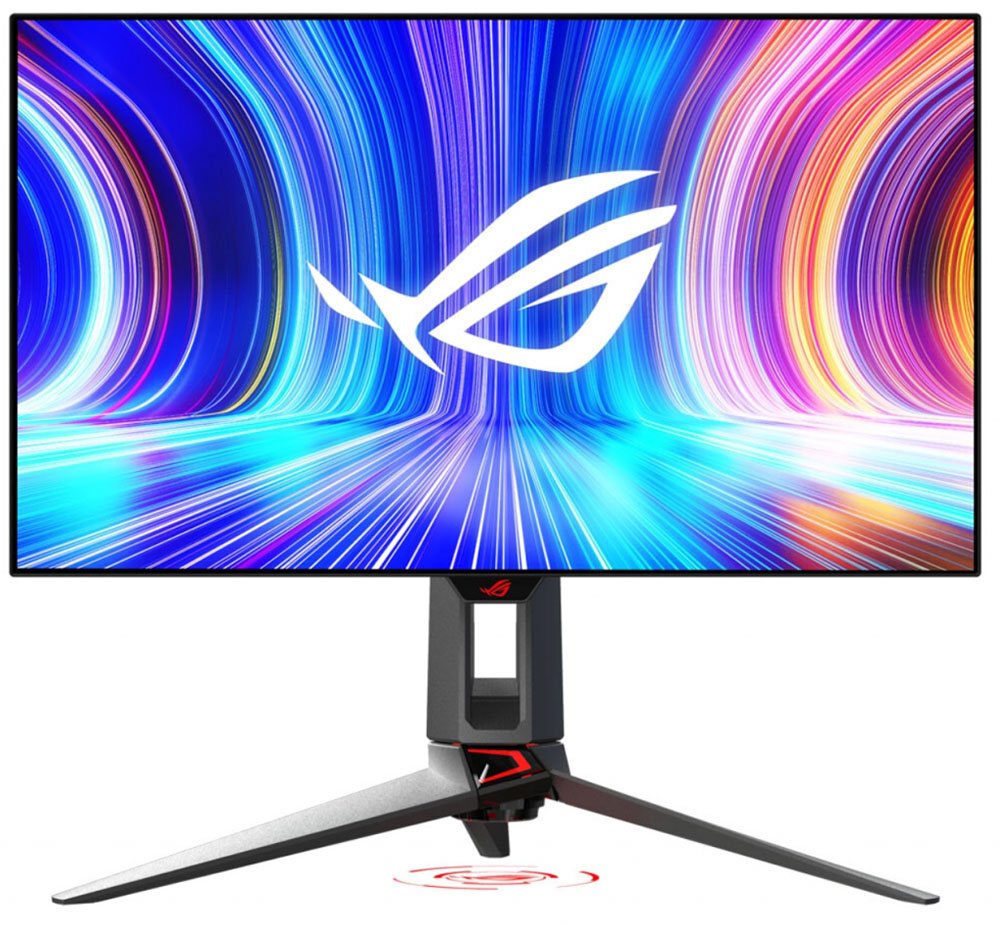
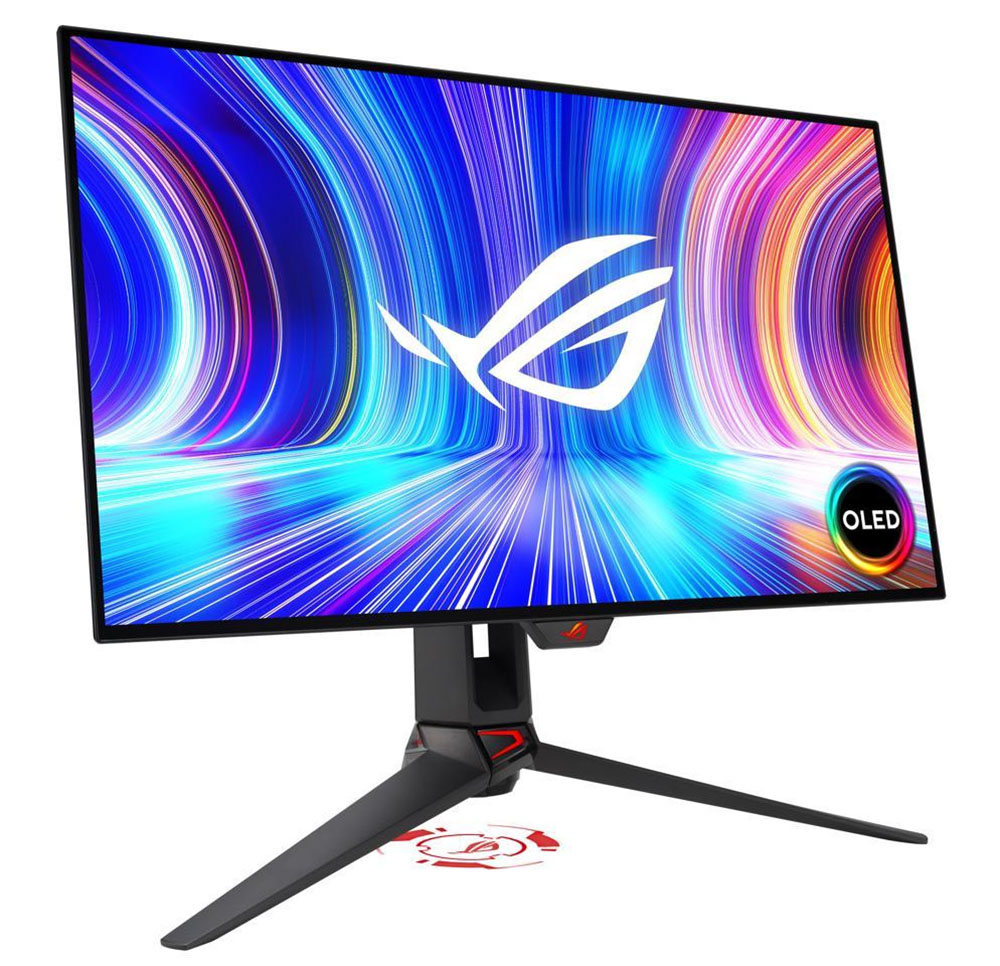
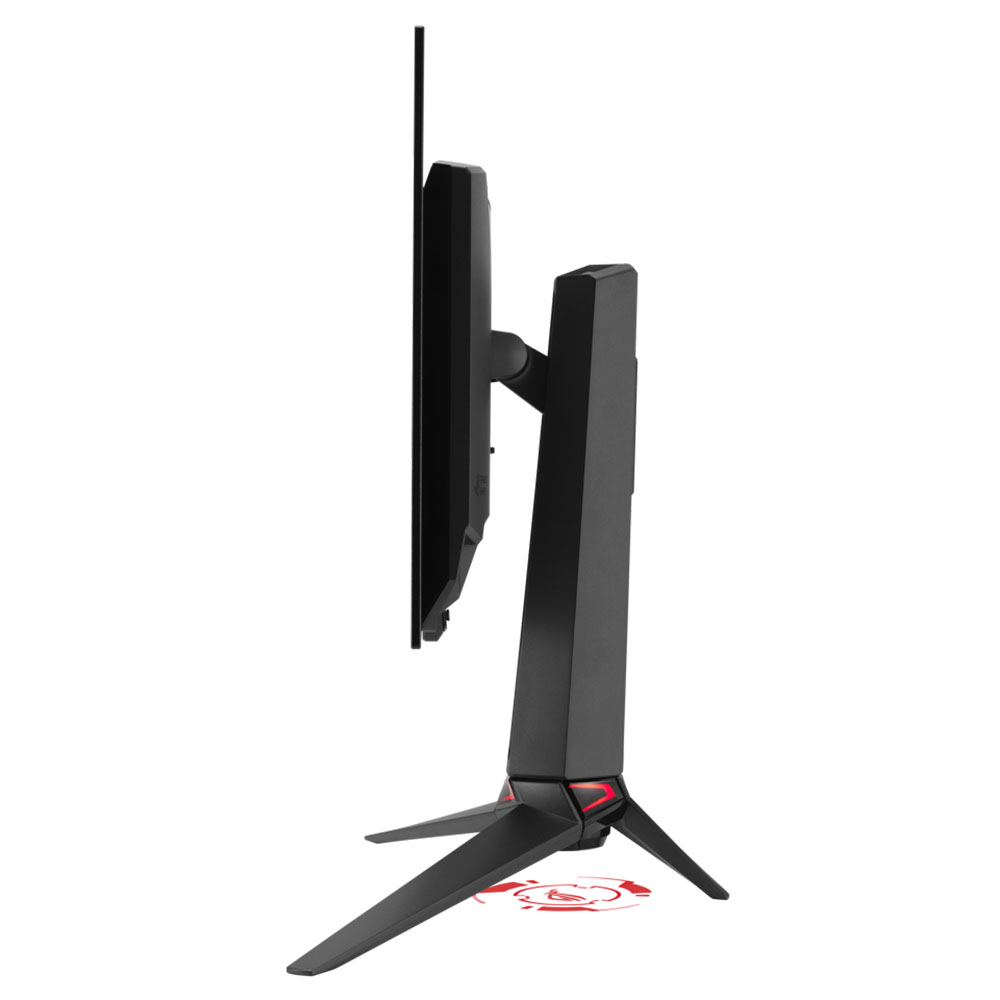
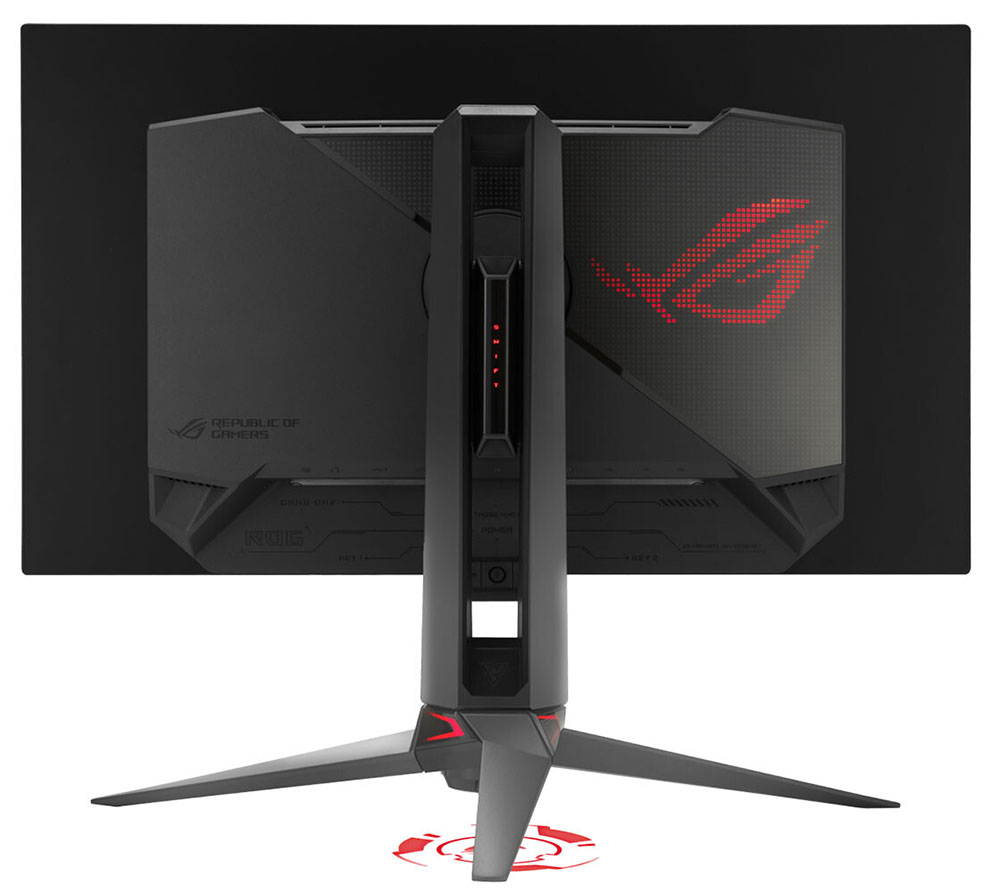
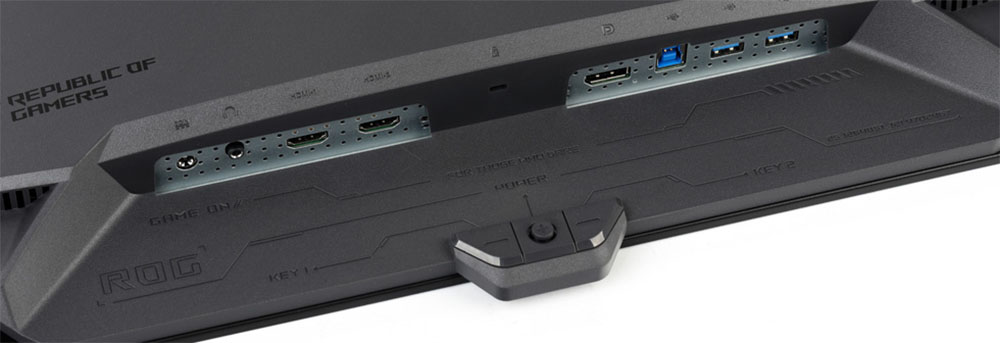
The PG27AQDM has relatively understated styling compared to other ROG displays. You won’t find the molded lines that look like spaceship hull plating here. The screen has an anti-glare layer that’s shinier than most LCDs but less so than a typical OLED television. I had no issues with reflections in my sunlit office.
The back features a large ROG logo backlit by LEDs in a pixelated design. It also says “Swift” in tiny letters on the upright. This bar goes up and down with the panel. The stand also features LED accents and a projector that puts the ROG logo on your desktop. All the lighting is controlled in the OSD with various colors and effects, or you can turn it off.
The stand offers full ergonomics with 110mm (4.3 inches) height, 30 degrees swivel, 5/20 degrees tilt and a 90-degree portrait mode. You can rotate the panel in either direction. All movements are super tight and free of play. My only nitpick is that there’s no detent for the rotation, so I had to use a level to get the monitor perfectly straight.
At the bottom center of the screen is a tiny protrusion with a backlit ROG logo. Behind this are two control keys and a joystick for the OSD. The bezel is super thin, with just 9mm of flush framing around the top and sides and 11mm at the bottom. The panel is thin as well. With the component bulge, it’s 50mm (2 inches) deep, but apart from that, it’s just 5mm thick. If you’d rather use your own mount, a stamped steel adaptor bracket is included with a 100mm VESA lug pattern.
Inputs are up and under with a DisplayPort 1.4 (w/DSC), two HDMI 2.0 and USB, one upstream and two down. There are no internal speakers, but you get a 3.5mm headphone jack.
OSD Features
The OSD is extensive but relatively simple to navigate. You won’t find many video processing options like overdrive or blur reduction because they aren’t necessary. There are plenty of calibration controls, lighting menus, and other convenience features.
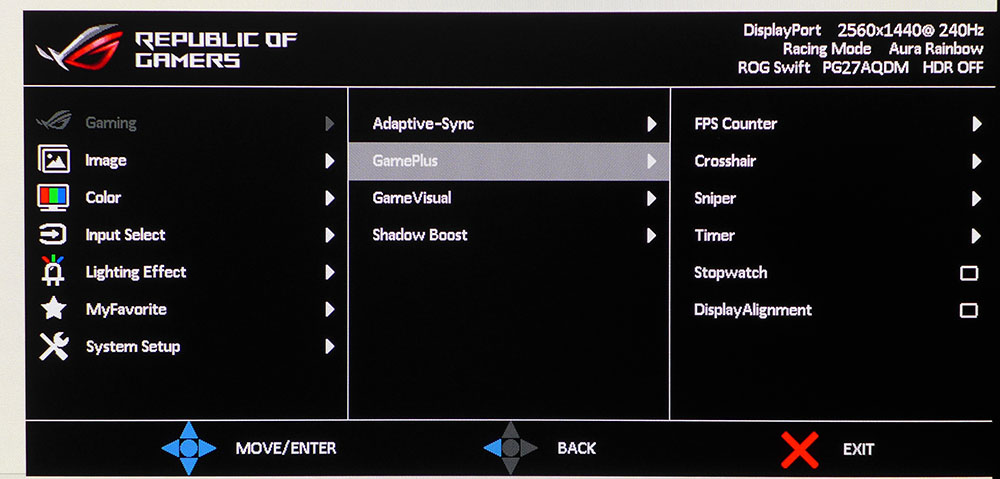
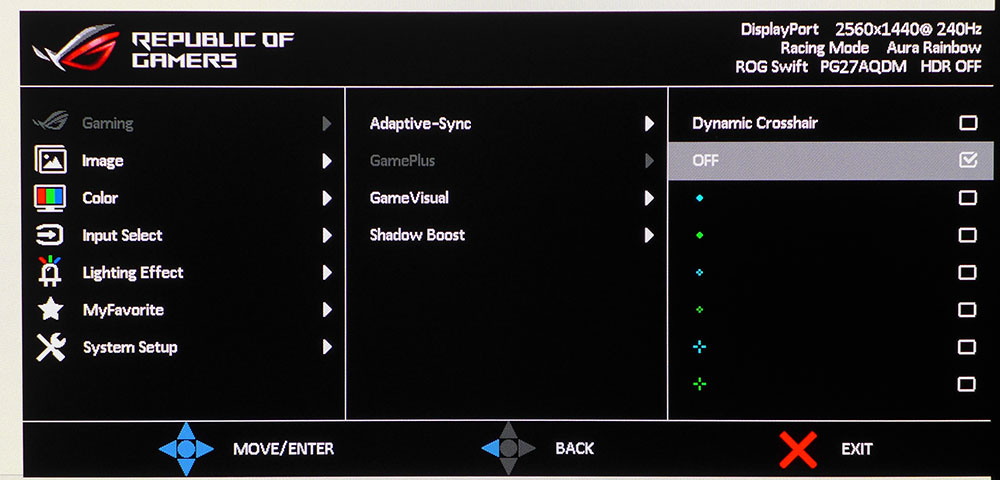
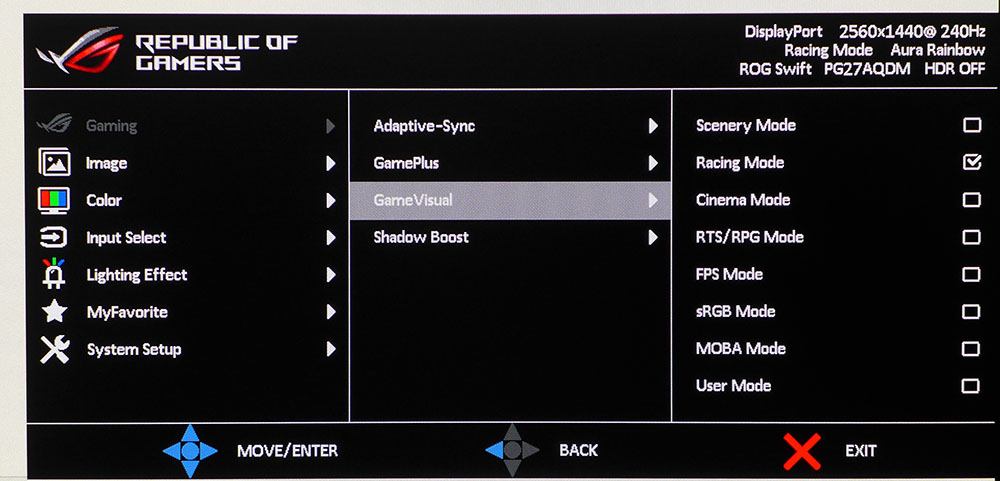
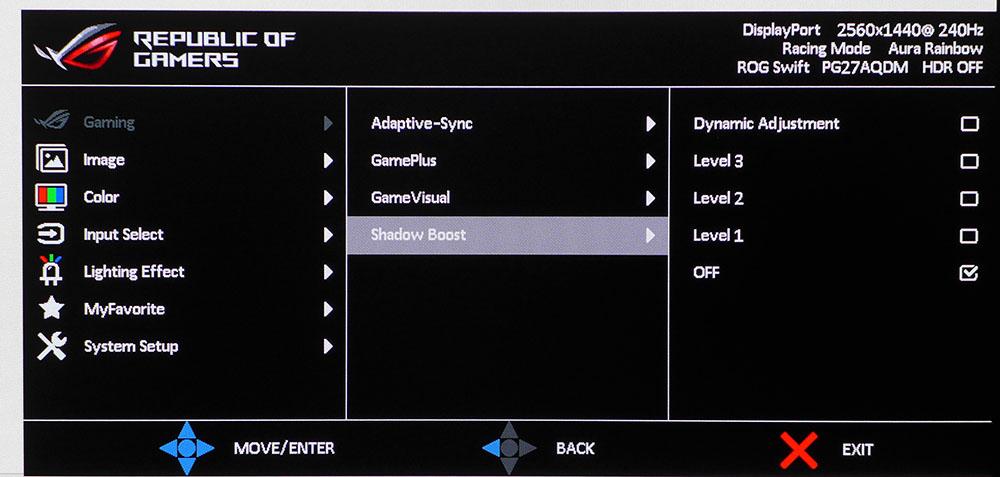
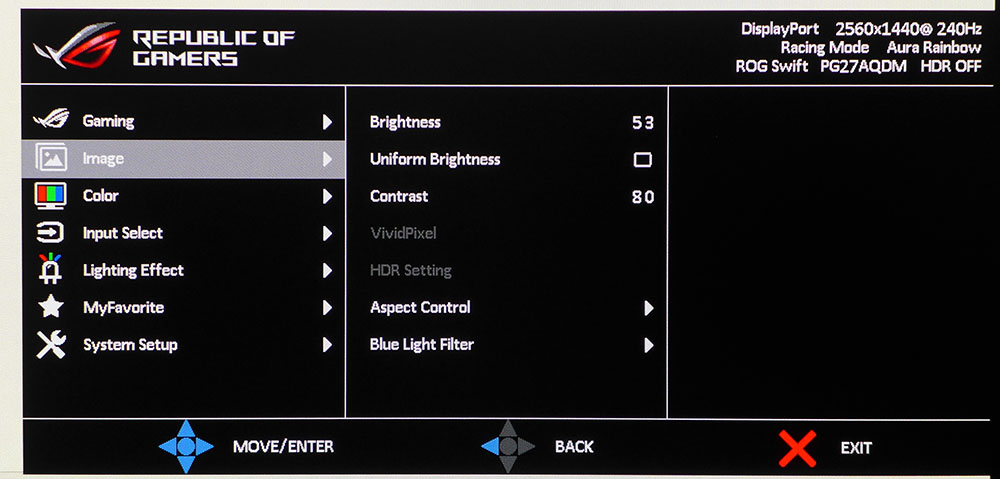
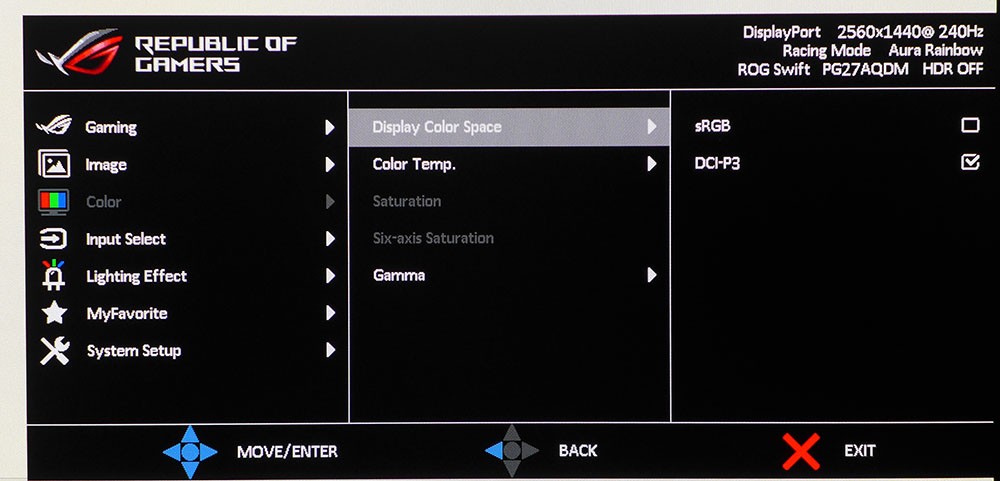
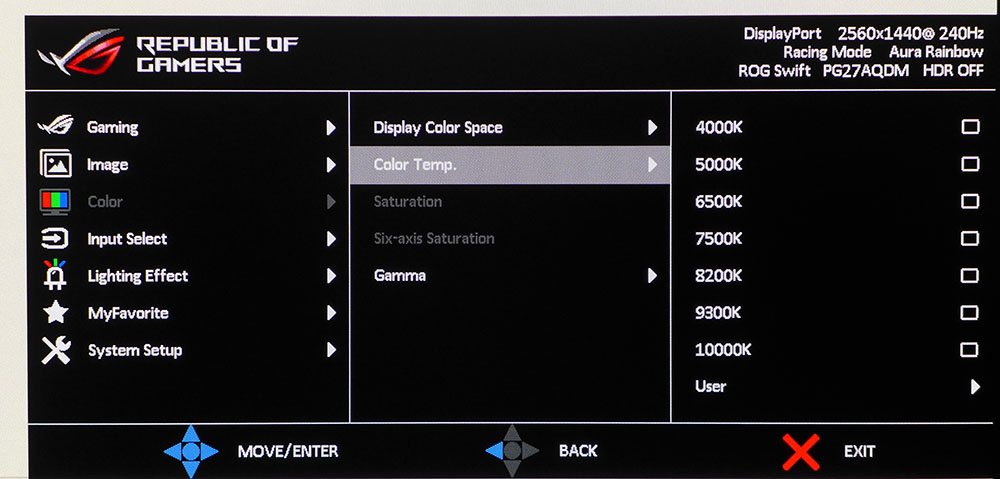
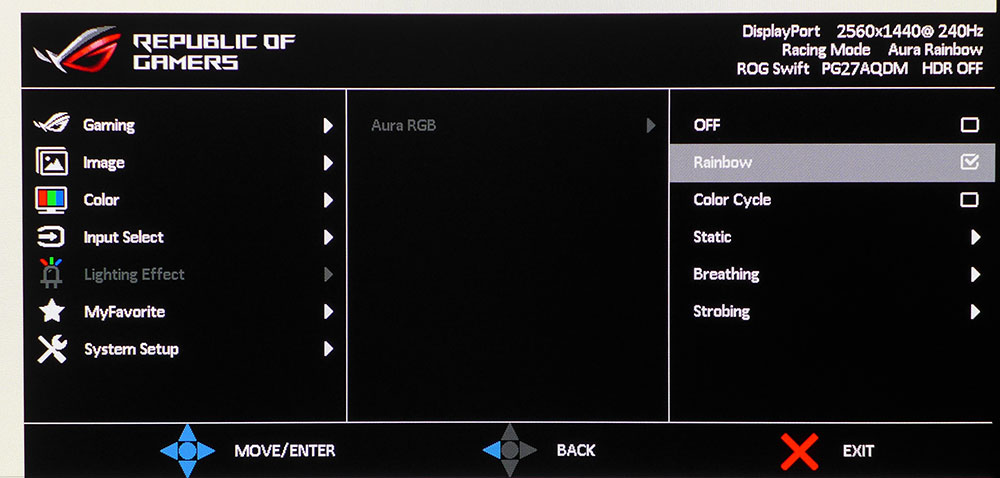
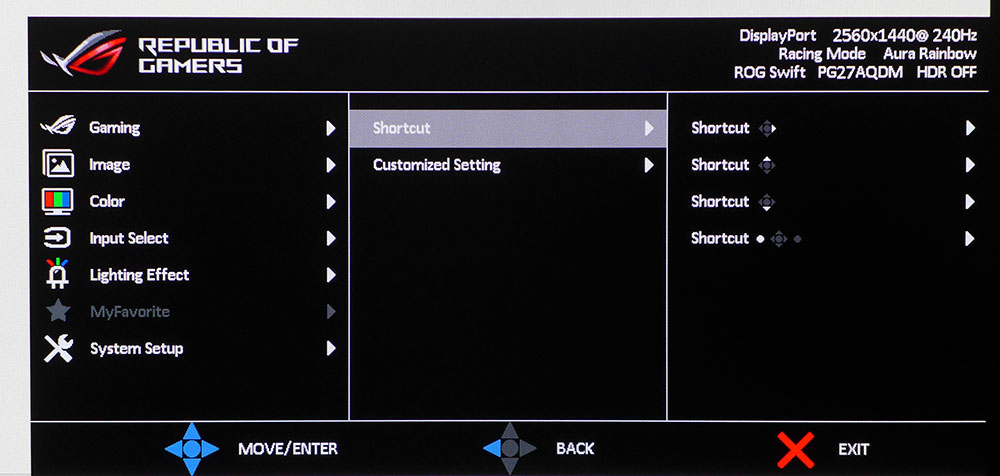
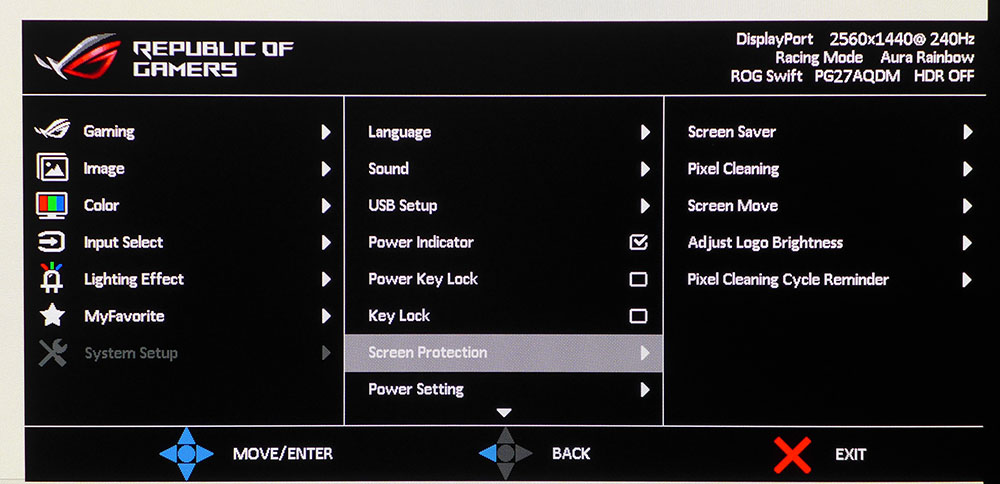
Asus users will have seen the PG27AQDM’s OSD before. It’s laid out in a familiar fashion, starting with the Gaming sub-menu. You can toggle Adaptive-Sync and choose between a full set of Game Plus enhancements like aiming points, timers, stopwatch, frame counter and a sniper mode that magnifies the center of the screen. GameVisual is the nine picture modes; Racing is the default, and you can leave the monitor set to that mode and enjoy a near-perfect image with no tweaking required. Shadow Boost has three levels and an automatic mode that works a bit like dynamic contrast. I did not need this in the games I played, so I left it off.
The Image menu has traditional luminance sliders and a uniformity option. This was unnecessary on my sample and only served to dim the picture. A Blue Light Filter alters the image to reduce fatigue during long work sessions.
You can calibrate the PG27AQDM in several ways. There are selectable gamuts, sRGB or DCI-P3, as well as color temps by Kelvin value from 4,000 to 10,000K, and a user mode with RGB sliders. I only made a tiny improvement using them, so I recommend leaving this set to 6500K. You can also pick from five gamma presets ranging from 1.8 to 2.6.
The Aura RGB lighting refers to the logo projector and the graphic on the panel’s backside. There are multiple effects and colors available, or you can shut the whole thing off for a stealthy look.
The joystick’s directional movements can be assigned to shortcuts like brightness or picture mode, which is handy for quick access when you don’t want to dig through the OSD.
Users concerned about OLED burn-in will find an array of screen protection features like a screen saver, pixel cleaner and an orbiter that shifts the image by one or two pixels. This operation is entirely invisible. Adjust Logo Brightness dims the bottom right corner of the screen where TV channel logos often reside. The Pixel Cleaning Reminder can be set to remind you every two, four or eight hours to run the routine. It takes about six minutes and begins after the monitor enters standby mode.
Asus ROG Swift PG27AQDM Calibration Settings
In the PG27AQDM’s Racing mode, no calibration is necessary. In fact, my adjustments barely made a difference. If any monitor can be called “factory calibrated,” it’s this one. To set brightness, I measured 25% window patterns rather than full fields. Brightness is reduced as more of the screen lights up. I’ll talk more about this on the next page. I arrived at the settings below using that test method, but you may want to turn the brightness up more if your room is well-lit. The default color gamut is DCI-P3 which the PG27AQDM covers almost 97% of. If you want sRGB, there’s a gamut option that works in the Racing picture mode or an sRGB picture mode. The latter is a more accurate choice.
In HDR mode, three additional picture modes exist: Gaming, Cinema and Console. Gaming is the best choice. You can also turn on a brightness adjustment to tone down the image. I had no need for this. The PG27AQDM’s HDR is about as good as it gets right out of the box.
Gaming and Hands-on
Using an OLED panel as an everyday monitor is an absolute treat. Every kind of image, static or moving, is made better by the PG27AQDM’s incredible contrast. Blacks are truly black but still rich with detail. Though I had calibrated my sample, the change from its out-of-box state was invisible. You don’t need to adjust this monitor aside from setting brightness, which requires trial and error. I initially set the level using a 25% window pattern to 200 nits. That proved a little too dark when viewing fullscreen content. I turned the slider up to 60, which is the default value. This matched the image better to my sunlit office. You will find that some tweaking is necessary to find a comfortable level for your space.
Color saturation is quite high but never overblown. I had no complaints using the PG27AQDM’s full native gamut for all content. I only reached for the sRGB mode when editing photos. There, you’ll want to be sure you’re grading color properly for monitors that don’t have a wide gamut.
The contrast is so deep that the QHD resolution is a non-factor. You can see the pixel structure if you put your face right up to the screen. But OLED always looks sharper to me than an LCD running at the same resolution. It’s a visual perception because the actual pixel gap is about the same between the two panel types. There’s that contrast again. It always adds to the perception of fine detail and clarity. Document editing is easy and comfortable thanks to the broad range between black fonts and white background.
Gaming is an enhanced experience on two levels. Image quality is tremendous, with realistic environments and fine detail that pops from the background. Character faces are realistically textured with a tactile feel. Video processing is also enhanced. There’s no overdrive to tweak because motion resolution is perfect without it.
I played my usual game suite of Tomb Raider, Call of Duty WWII and Doom Eternal at max detail at 240fps. With the recent addition of a GeForce RTX 4090 to my test PC, I can now play at the full potential of the fastest monitors available. I have observed that all OLEDs are smoother than LCDs running at the same frame rate. I get better motion resolution from the PG27AQDM at 240fps than from a 240 Hz QHD LCD like the BenQ EX270QM. I also noticed the incredibly low input lag. This monitor is one of the quickest I’ve ever tested. It is completely qualified for professional competition gaming.
When a monitor is this responsive, it’s far easier to aim on the move and fire when you intend to. Defensive movements are also more natural and controlled because you can start and stop exactly when and where needed. This level of precision makes gaming far more addictive and comfortable. I felt as though the PG27AQDM and my peripherals were simply extensions of my hands and eyes.
I’m not sure it’s possible to overstate the high playability and premium feel of this monitor. It also delivers a stunning image making it hard to find any faults. I experienced no problems during my many hours of gameplay. I also used the PG27AQDM for work tasks and found it a pleasurable experience.
If you’re wondering about burn-in, I can only say that I didn’t use the monitor long enough to create any. OLEDs are not immune to this, and I recommend using the panel maintenance features Asus includes. The pixel cleaner takes about six minutes to run and only starts once you put the PG27AQDM in standby mode, so it’s completely non-intrusive. I left the pixel orbiter (Screen Move) on, and it never showed its operation. My only long-term experience with an OLED panel is the 65-inch LG GX-series television I’ve used daily for over two years. It shows no signs of burn-in at all.
MORE: Best Gaming Monitors
MORE: How We Test PC Monitors
MORE: How to Buy a PC Monitor: A 2022 Guide
MORE: How to Choose the Best HDR Monitor
To compare the PG27AQDM’s performance, I’ve rounded up the most recent OLED monitors from my test database. They are a variety of sizes and shapes, and cover prices from about $920 to $2,000. They are Corsair’s Xeneon Flex, Asus’ PG42UQ, Alienware’s AW3423DWF and Aorus’ FO48U. To bring the total to six, I’ve added a Mini LED model, AOC’s PD32M.
Pixel Response and Input Lag
Click here to read up on our pixel response and input lag testing procedures.
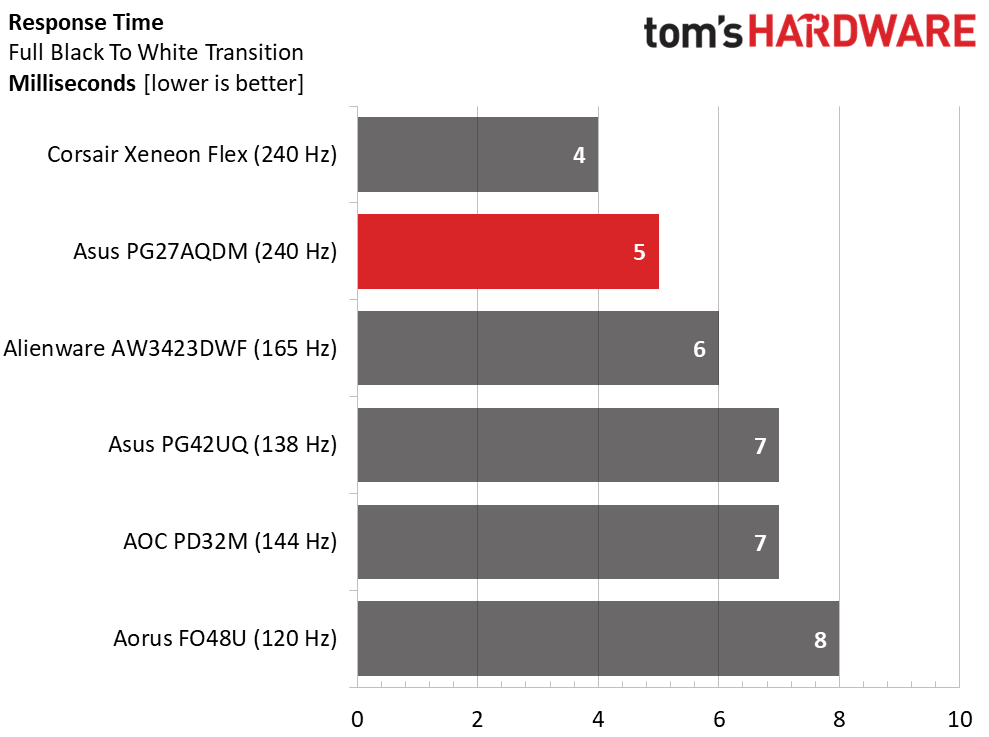
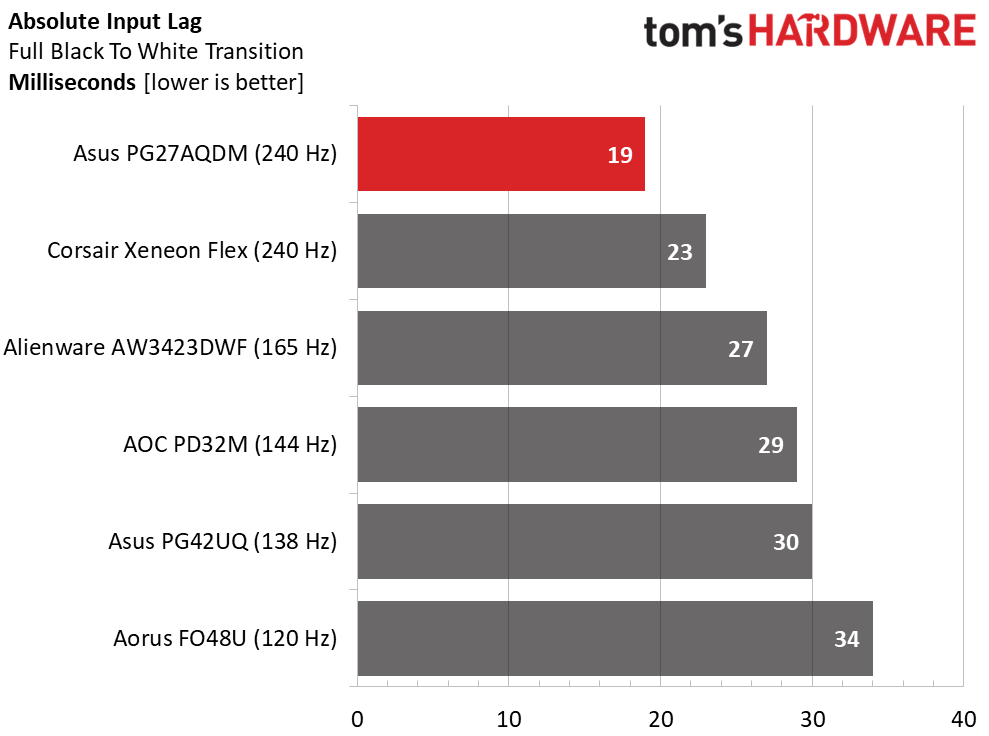
Response times go hand in hand with refresh rates, but OLED has better motion resolution than LCD just based on visual observation. Translation: if an OLED and an LCD run at the same frame rate, an OLED will look smoother. The Corsair takes the screen draw contest by 1ms, but I cannot visually tell the difference between them.
The PG27AQDM is one of the fastest monitors I’ve ever tested. Only a handful of panels have ever cracked 20ms, and they all run at 360 or 500 Hz. The advantage was plain during gameplay where I could aim precisely, stop exactly where I wanted, and see every detail clearly, whether moving or static. This monitor can play at any level, from casual to professional. And remember, there’s no overdrive or blur reduction here. Those features are unnecessary.
Viewing Angles
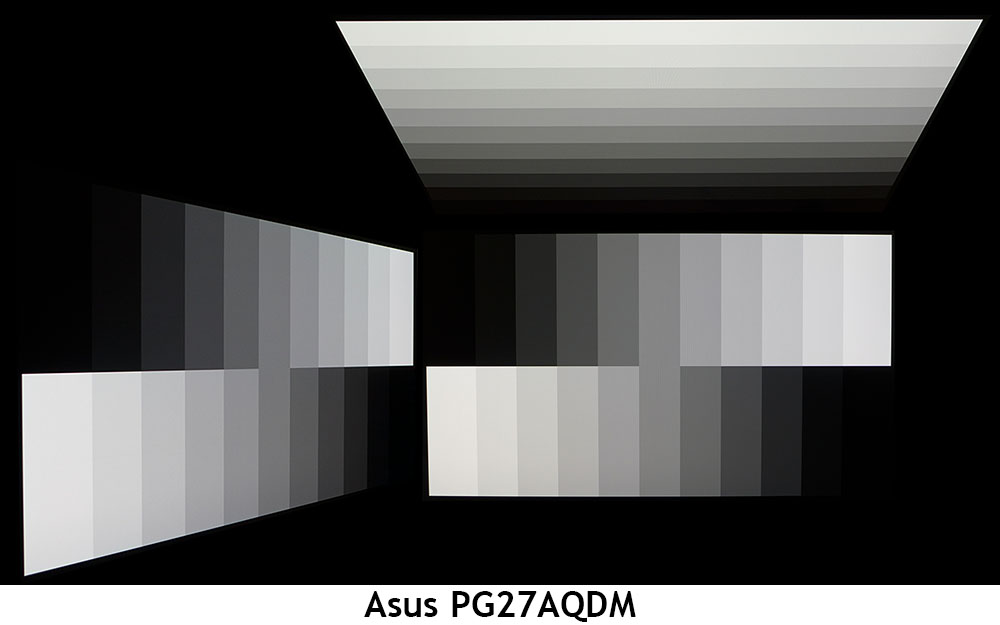
Off-axis image quality isn’t a major deciding factor for a monitor this small, but you can see in the photos that the PG27AQDM is on another level from any LCD panel. The head-on and side views are virtually identical, differing only slightly in color temperature. The top view is also very close, with just a small reduction in gamma. Though few users will share a 27-inch monitor, you can do it with this one.
Screen Uniformity
To learn how we measure screen uniformity, click here.
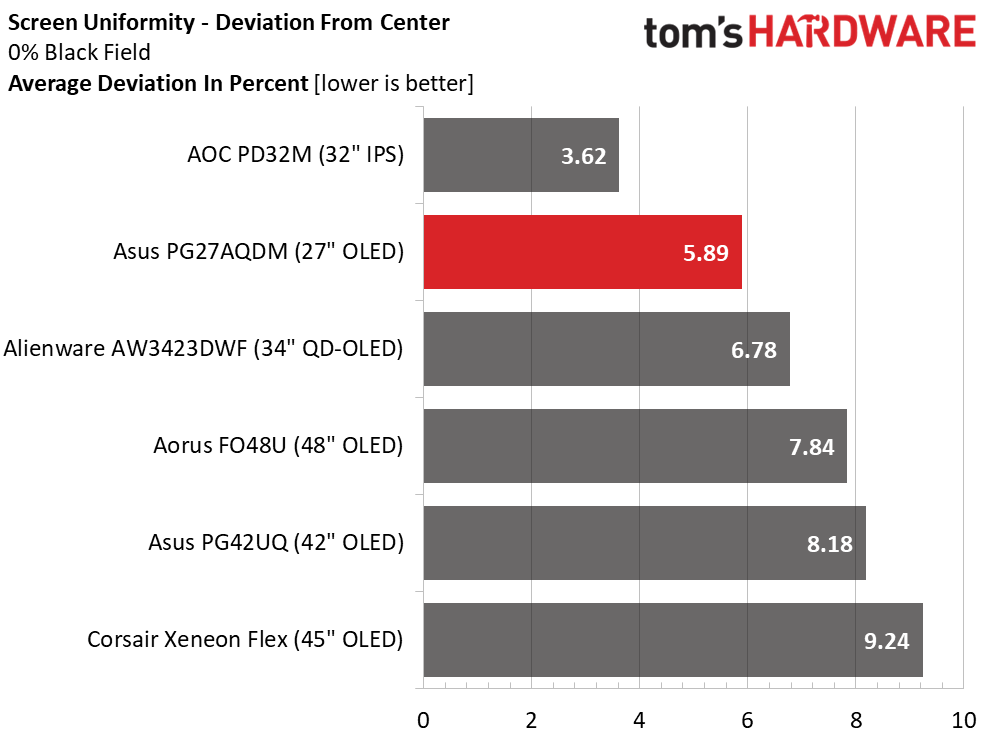
One of the PG27AQDM’s unnecessary features is its screen uniformity option. I measured my sample with it turned off and got a result well below the visible threshold. 5.89% is among the very best, with no hotspots, bleed or glow, even with all the room lights turned off. It doesn’t get much better than this though the AOC also excels in this test.
MORE: Best Gaming Monitors
MORE: How We Test PC Monitors
MORE: How to Buy a PC Monitor: A 2022 Guide
MORE: How to Choose the Best HDR Monitor
To read about our monitor tests in-depth, please check out Display Testing Explained: How We Test PC Monitors. We cover brightness and contrast testing on page two.
Uncalibrated – Maximum Backlight Level
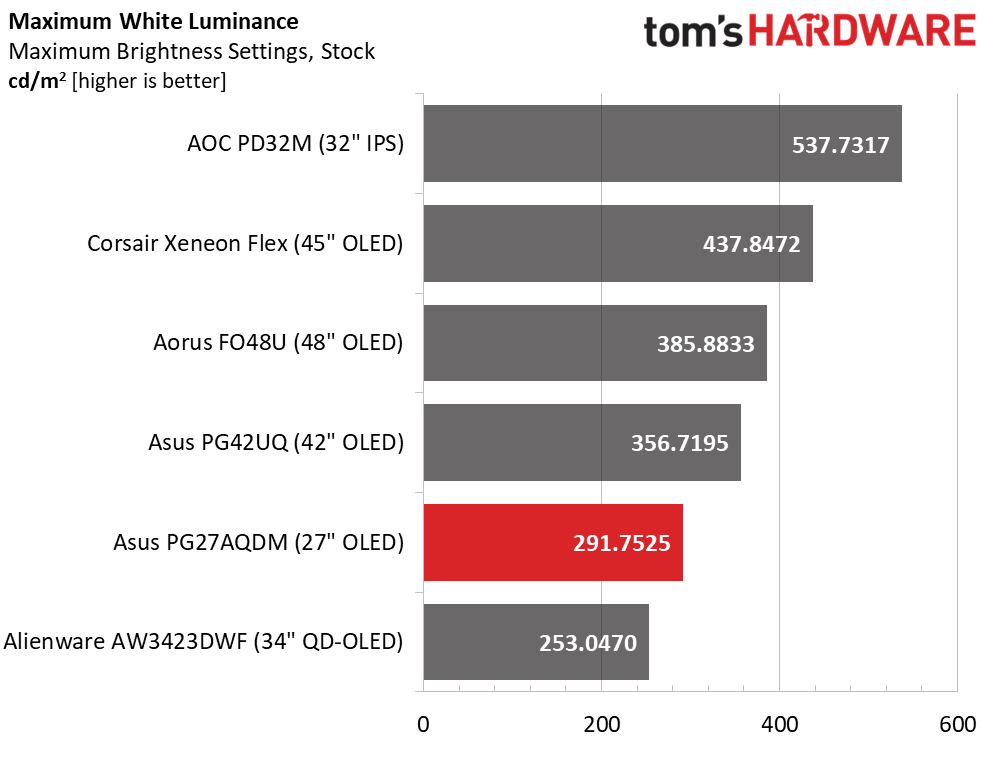
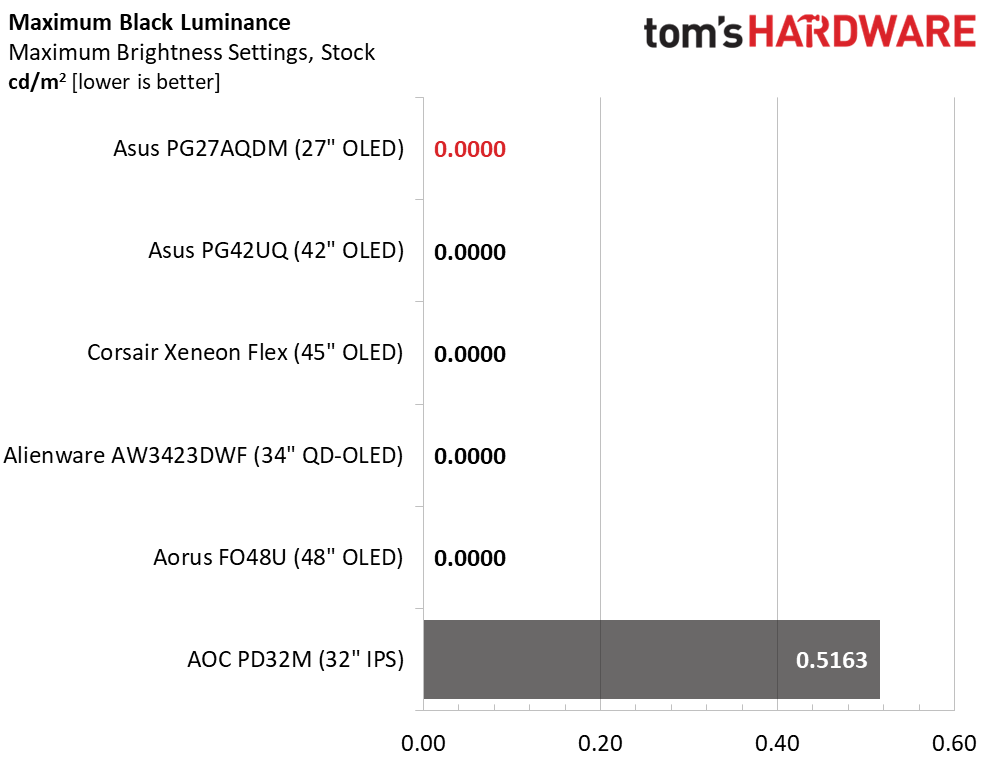
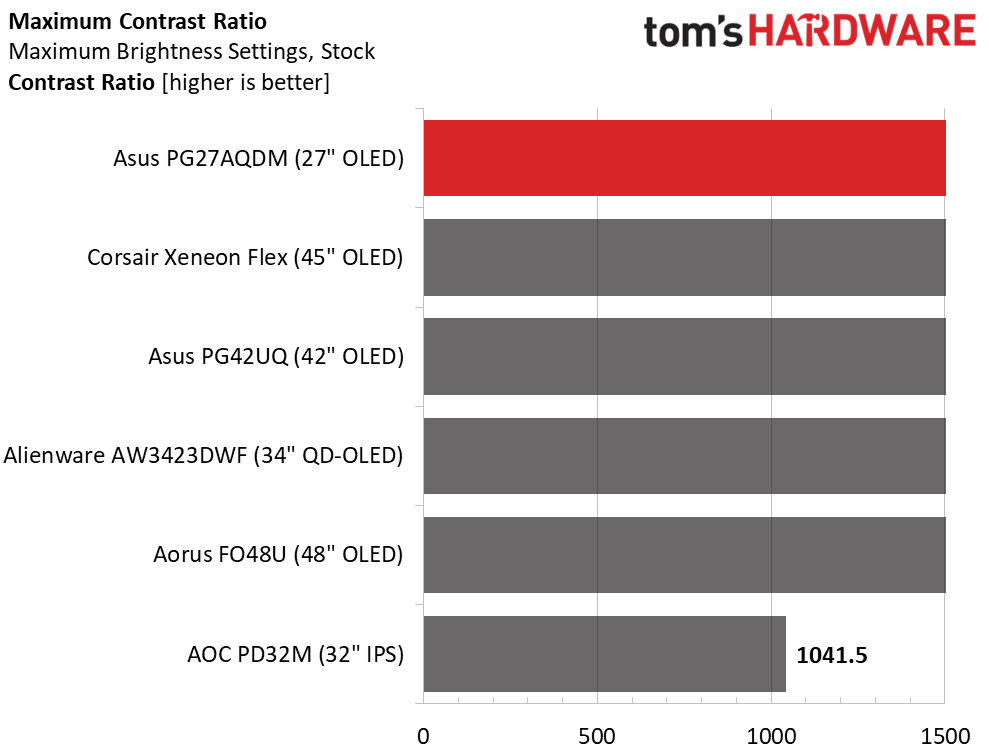
Opponents of OLED technology often cite peak brightness as a weakness. Indeed, LCDs are generally brighter than OLEDs, but the PG27AQDM has nothing to worry about. I measured a bit less than 300 nits in SDR mode using a 25% window pattern. A full field measured 212 nits, so some power management is happening even though I turned that option off. That’s not unusual for any OLED. Back in the days of CRT and plasma, it was called DC restoration. It’s meant to protect the display’s power supply from overloading when showing the brightest content. The only thing affected here is where one would set the peak output level. I used window patterns for all tests, so users reading this may want to employ higher brightness values to get the peak level to their liking.
Like any OLED, black levels can’t be measured by any available instruments, so the contrast is theoretically infinite. The lone LCD here was tested with its local dimming turned off, so it delivered a typical-for-IPS 1,041.5:1 contrast ratio.
After Calibration to 200 nits
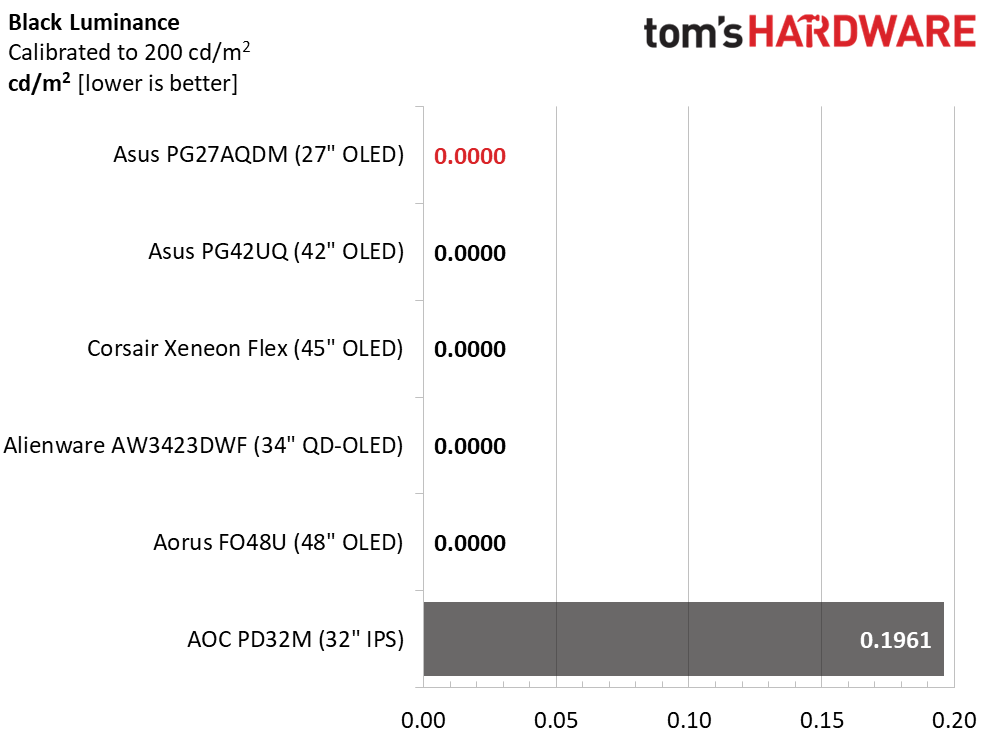
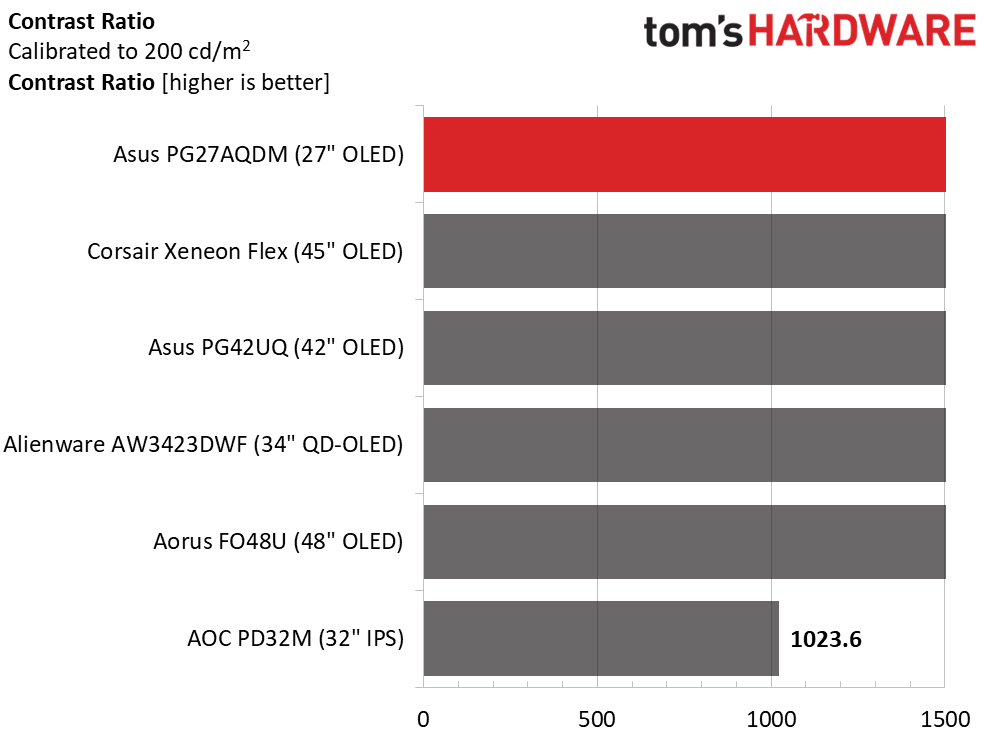
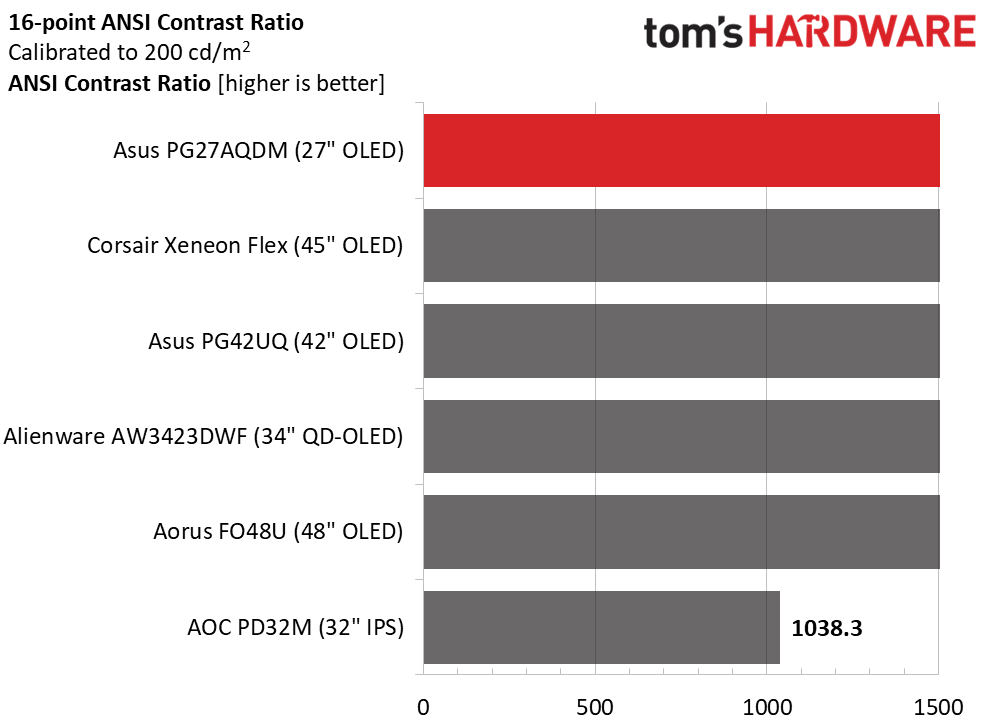
As stated earlier, I measured the PG27AQDM using 25% window patterns to achieve a realistic light reading. 200 nits is about halfway down the brightness control’s range. All the OLEDs retain their infinite contrast status.
ANSI contrast is also unmeasurable on an OLED. The AOC does well for an LCD but it’s easy to see the difference in a side-by-side comparison whether viewing test patterns or actual content.
MORE: Best Gaming Monitors
MORE: How We Test PC Monitors
MORE: How to Buy a PC Monitor: A 2022 Guide
MORE: How to Choose the Best HDR Monitor
Like all Asus monitors, the PG27AQDM ships in the Racing mode. In this case, it’s a great choice for picture quality and accuracy and does not need to be adjusted further. As you’ll see, there is almost no gain from calibration.
Grayscale and Gamma Tracking
Our grayscale and gamma tests use Calman calibration software from Portrait Displays. We describe our grayscale and gamma tests in detail here.
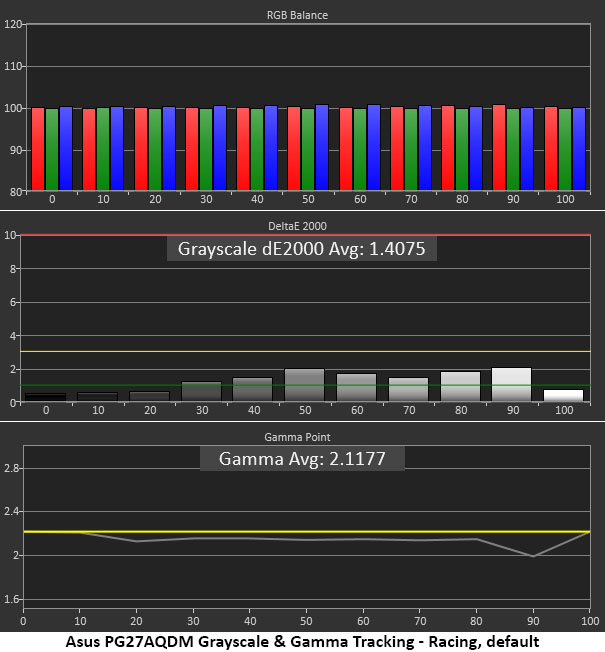
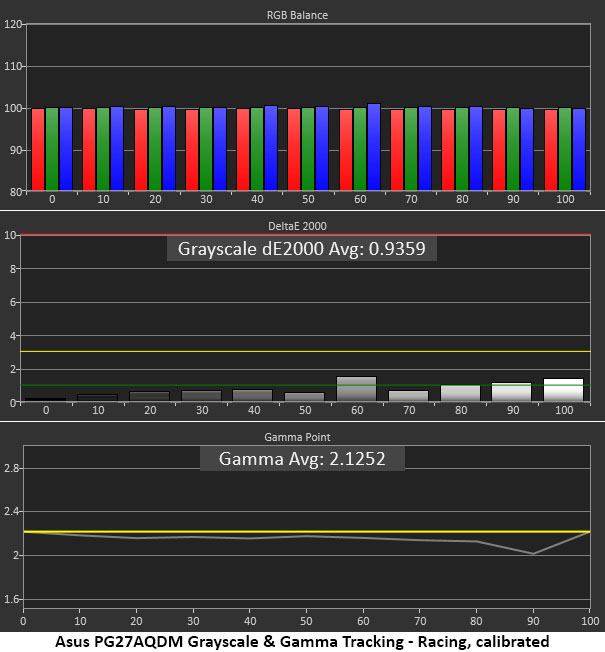
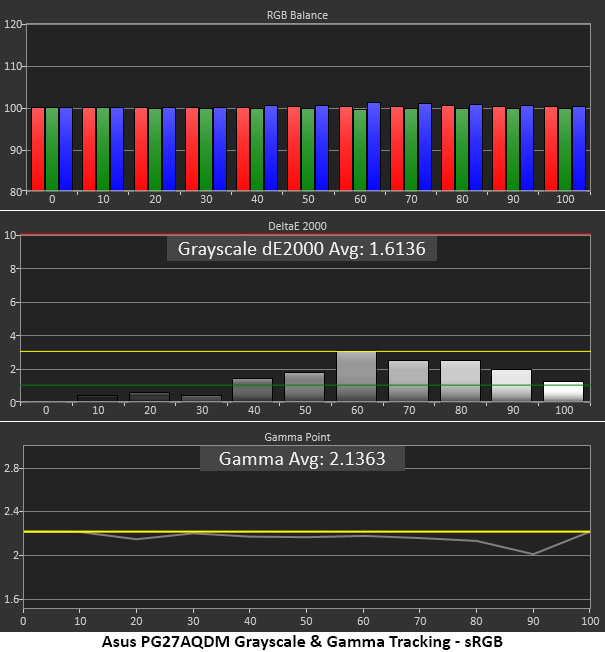
The default grayscale run shows no visible errors with all values under 2dE. Gamma is a little light, with a dip at 90%, but the dynamic range is so wide you can’t see an issue in actual content. Calibration only makes a difference in the error value. Visually, the two images are the same. Gamma barely changes too. This is excellent performance.
If you want sRGB color, you can pick the sRGB gamut in Racing mode or set the picture mode (GameVisual) to sRGB. The latter delivers better color. Choosing the former option makes the grayscale quite cool. My only gripe is that you can’t automatically switch gamuts between SDR and HDR like other Asus ROG monitors.
Comparisons
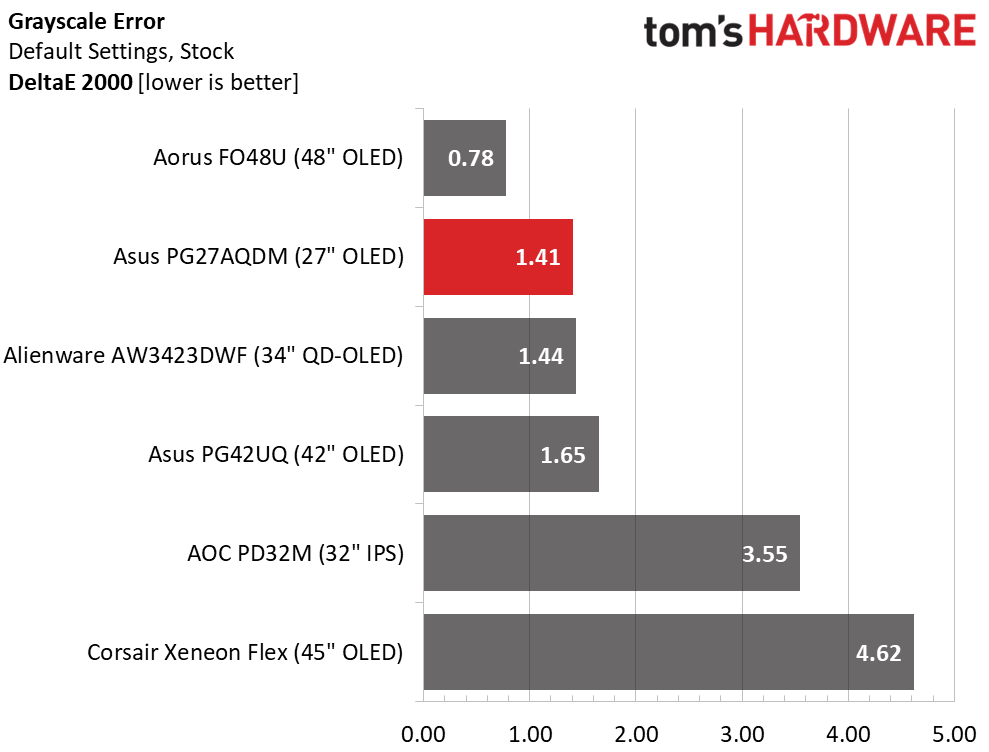
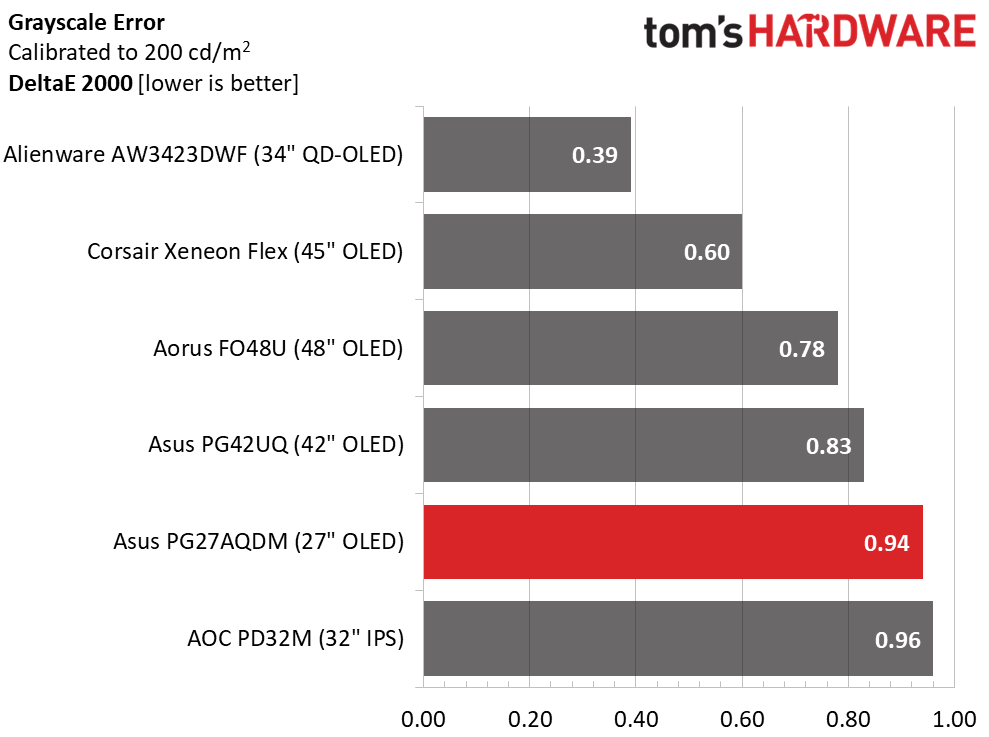
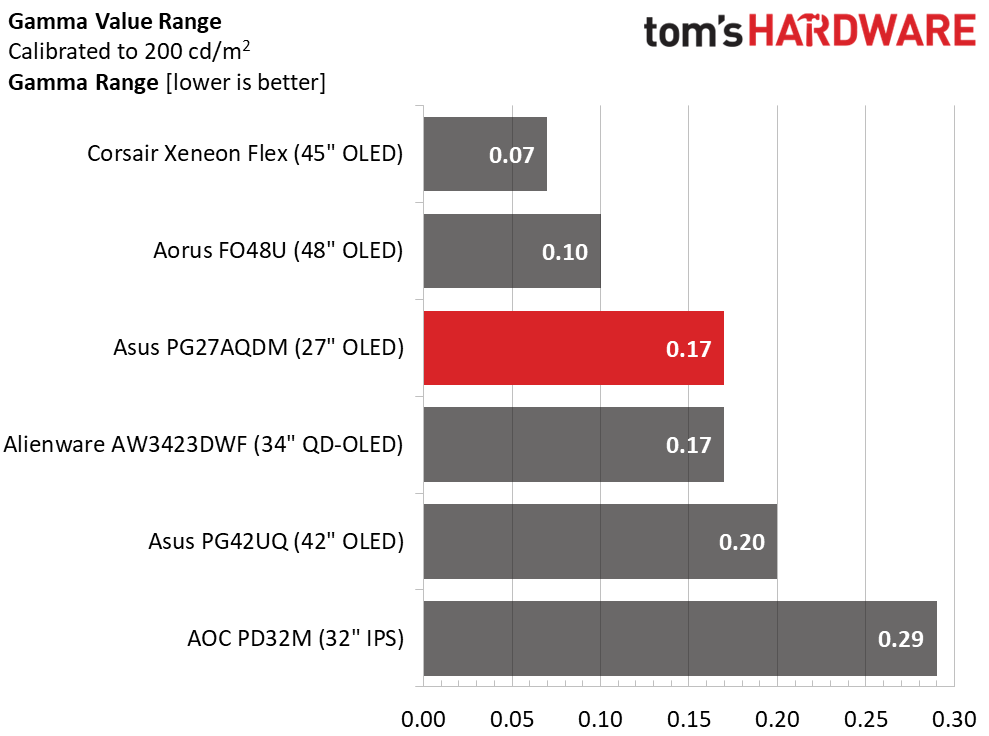
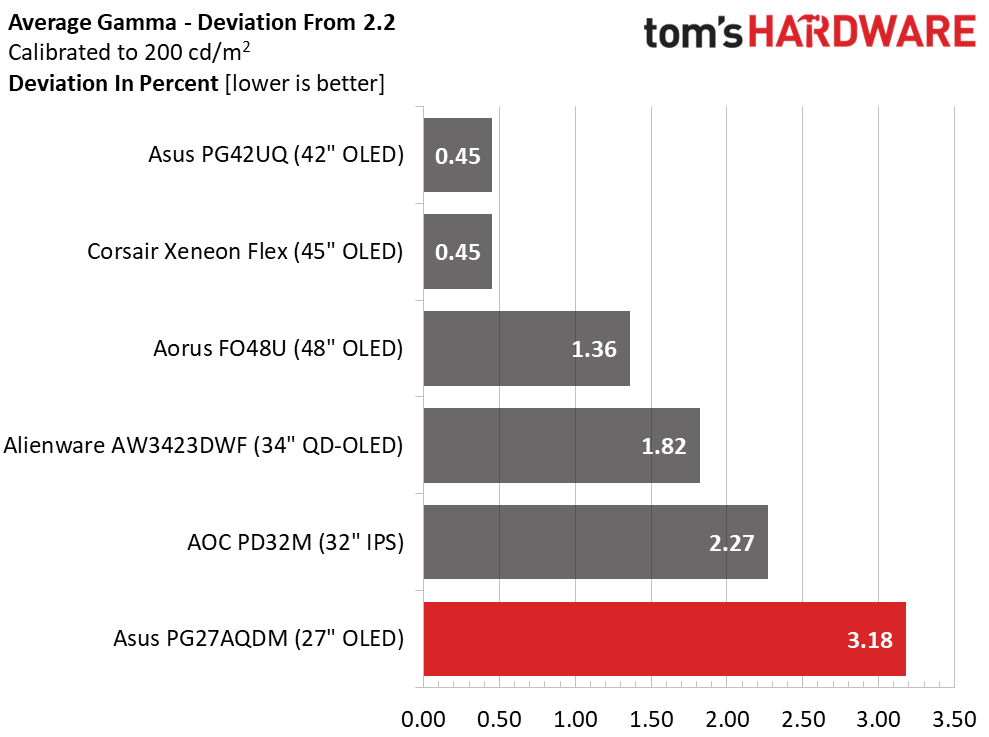
The PG27AQDM starts with a second-place finish in the default grayscale error test. 1.41dE is one of the best scores I’ve recorded, but the Aorus does even better. This is a minor point. Visually, the top four monitors are the same. After calibration, all six monitors have very low error levels.
The PG27AQDM’s gamma tracks straight, as evidenced by its 0.17 range of values. But the average is a tad light at 3.18% deviation, actual value, 2.13. This error is almost impossible to spot in an OLED panel because of its tremendous contrast.
Color Gamut Accuracy
Our color gamut and volume testing use Portrait Displays’ Calman software. For details on our color gamut testing and volume calculations, click here.
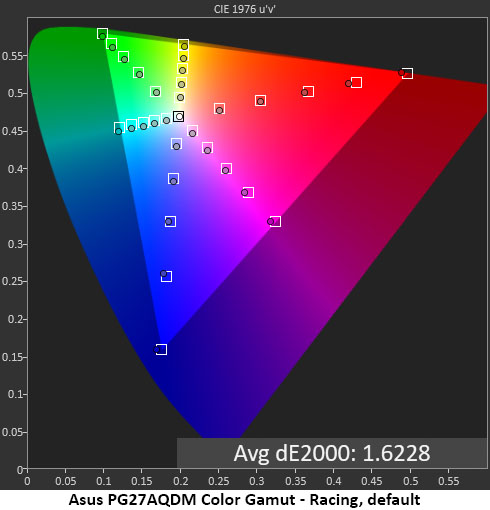
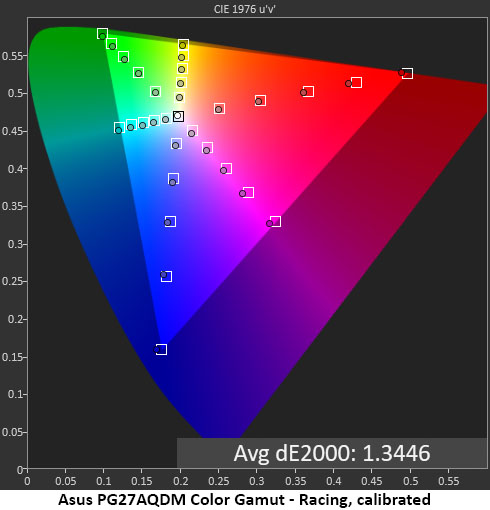
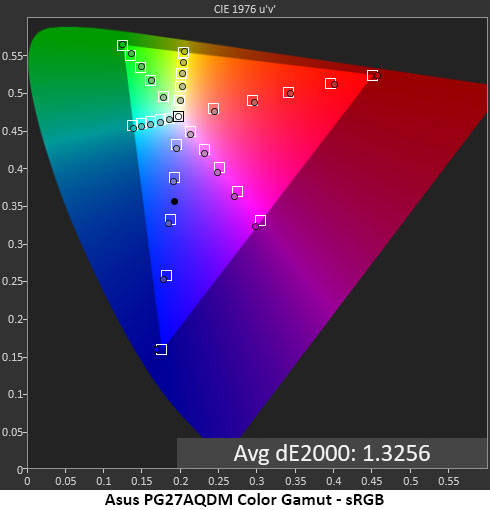
The PG27AQDM aced my color gamut tests for both DCI-P3 and sRGB. The default is DCI-P3; most users will likely use that for all content. The effect of calibration is negligible. Notice that the green primary is almost completely covered, a rarity in wide gamut screens. Red is a touch under-saturated at 80 and 100% but only slightly.
The sRGB test goes by with flying colors. Not only is the error of 1.33dE incredibly low, but the gamut is completely covered. The white point and gamma are near-perfect as well. It doesn’t get much better than that.
Comparisons
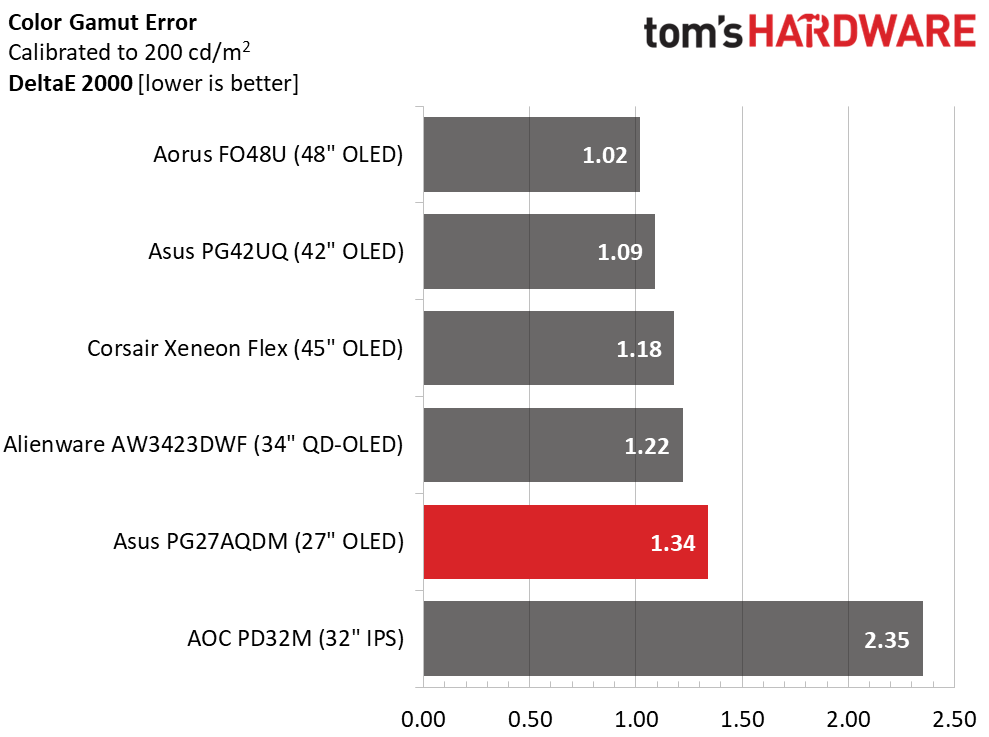
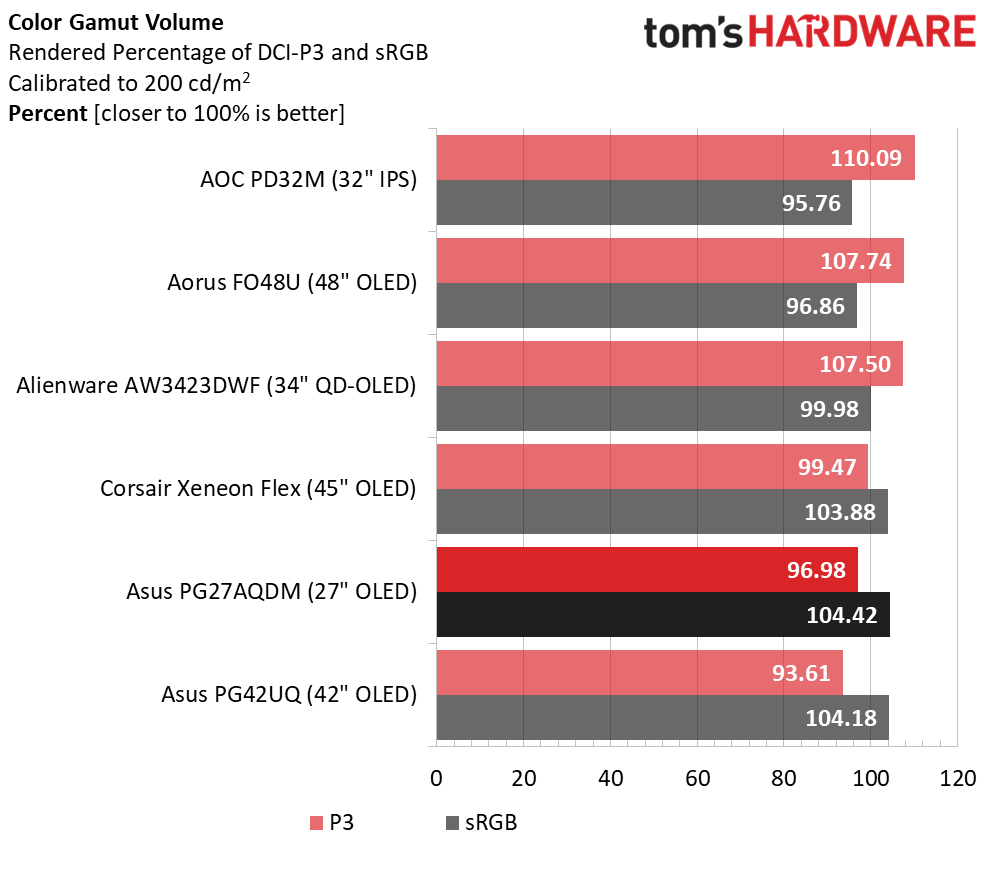
The PG27AQDM’s color performance is superb, like all the OLEDs in this comparison. The AOC is only slightly behind in accuracy, though visually, the difference is minute. OLED also has consistently large gamut volumes, with the lowest performer still topping 93% of DCI-P3. In this group, the AOC’s Mini LED with its Quantum Dot layer takes the crown with a good bit of extra punch in the primary colors. But the OLEDs aren’t far behind, with the Asus holding its own. It also covers the largest volume in the sRGB test. The PG27AQDM is well-qualified for color-critical work and can be used in a professional setting.
MORE: Best Gaming Monitors
MORE: How We Test PC Monitors
MORE: How to Buy a PC Monitor: A 2022 Guide
MORE: How to Choose the Best HDR Monitor
Our HDR benchmarking uses Portrait Displays’ Calman software. To learn about our HDR testing, see our breakdown of how we test PC monitors.
The PG27AQDM has three HDR picture modes that appear whenever an HDR10 signal is present. You can also adjust the brightness if you wish though I didn’t find a need for this.
HDR Brightness and Contrast
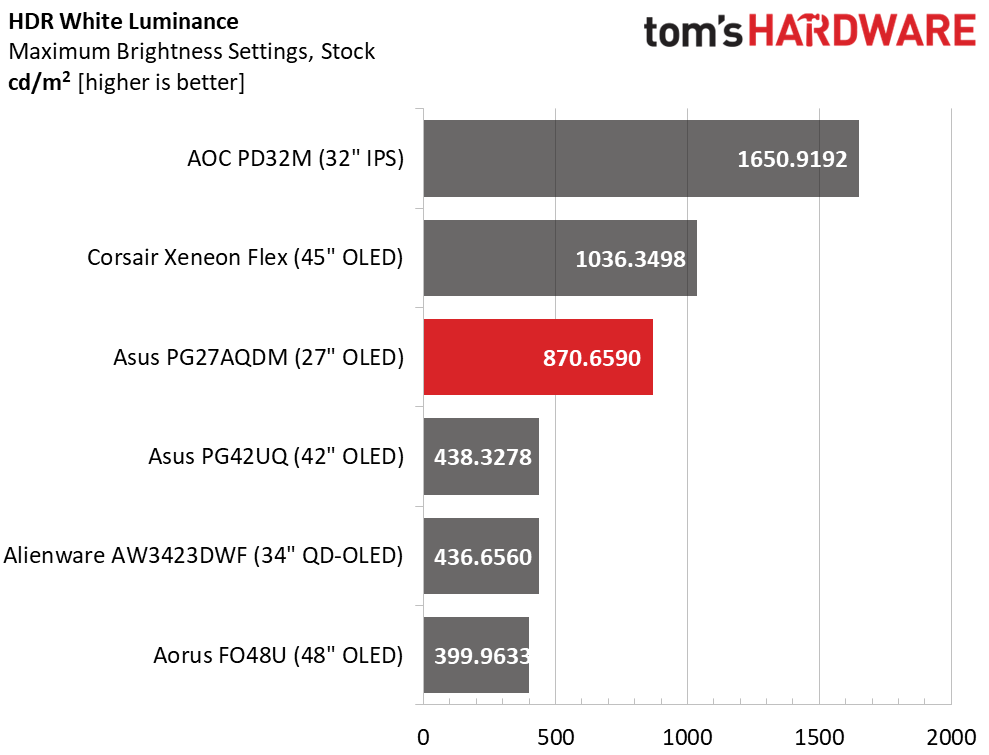
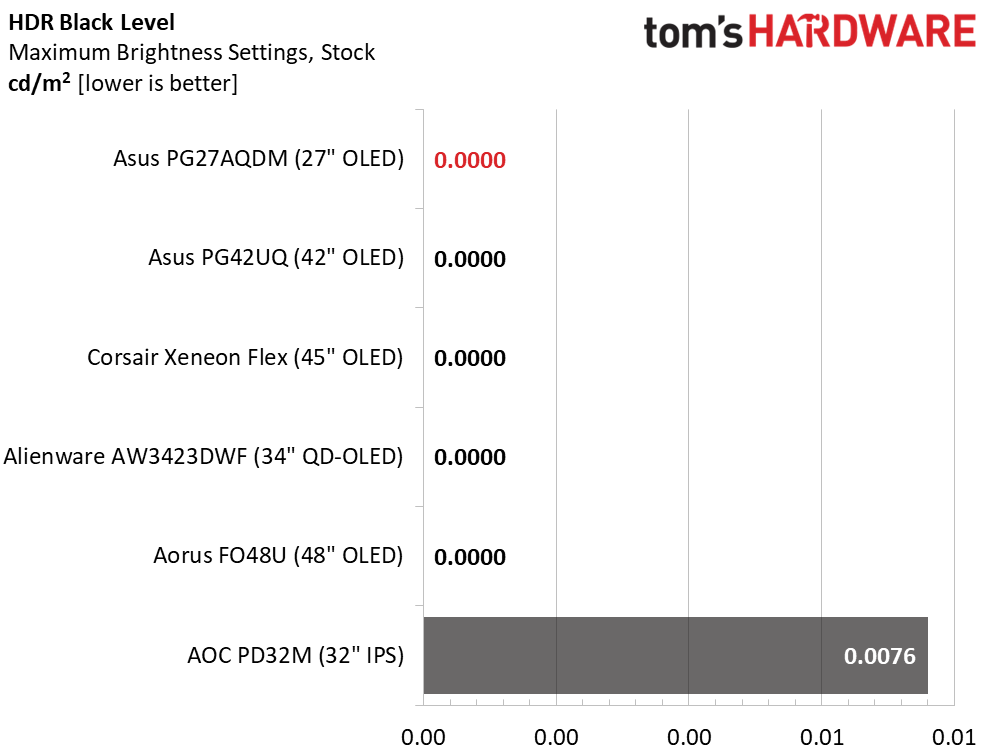
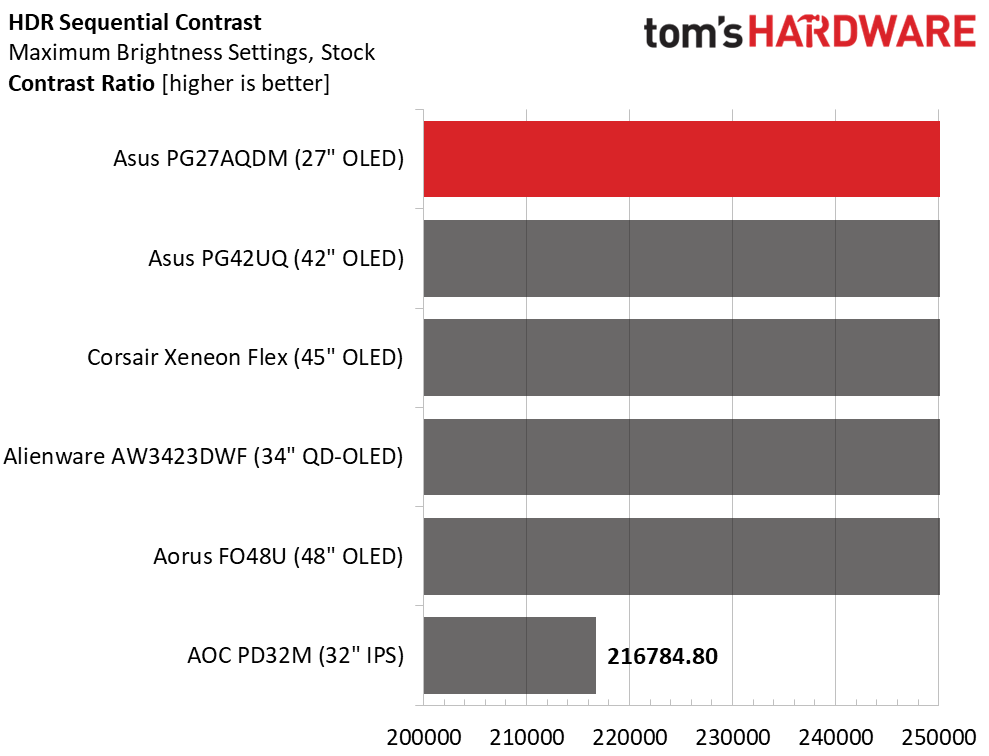
A lot is made of peak brightness when it comes to HDR, and while that is a factor, black levels are a much more important metric. That’s where OLED has the advantage. The PG27AQDM has plenty of peak output, over 870 nits, when measuring a 25% window. Asus claims 1,000 nits which I don’t doubt, but I didn’t have a small enough window pattern to achieve that number. However, the zero black level means HDR dynamic range is infinite. Can you tell the difference between an OLED and the PD32M? Having just reviewed it, the answer is yes. In a side-by-side comparison, the PG27AQDM has a deeper and more three-dimensional image for HDR and SDR. If you want the ultimate in picture realism, OLED has no equal.
Grayscale, EOTF and Color
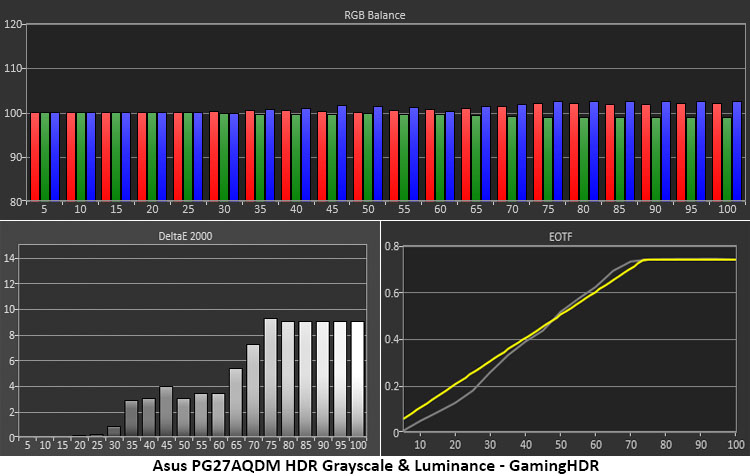
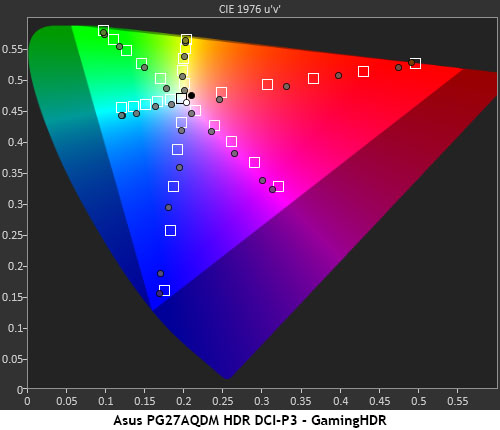
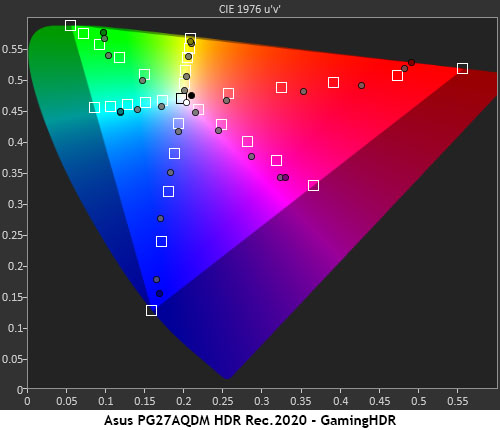
The PG27AQDM’s HDR grayscale tracking is a tad cool in the brighter parts of the image, but the error is visually small. I would be happy to have access to the RGB sliders to correct this, but that is a minor point. The luminance curve tracks a little dark until the mid-tones where it crosses the reference line to a slight overshoot. The transition point is at 70%, meaning all values over that are tone-mapped by the display rather than the content metadata. This is typical performance for a bright monitor, so what you’re seeing here is a good thing.
The PG27AQDM covers the DCI-P3 gamut with some over-saturation but nothing that will reduce detail. The HDR image has rich and vibrant colors enhanced by deep contrast. The Rec.2020 chart shows much the same behavior. Color runs out around 80%, which is typical of most OLEDs. The Asus’ HDR image quality is stunning, but other OLEDs are on par with it. However, it is on another level above Mini LED.
MORE: Best Gaming Monitors
MORE: How We Test PC Monitors
MORE: How to Buy a PC Monitor: A 2022 Guide
MORE: How to Choose the Best HDR Monitor
The desktop OLED monitor is no longer the unicorn it once was. I used the term “desktop OLED” over 10 years ago to describe high-contrast VA panels. I think it was something like, “there’s no more contrast to be had this side of a desktop OLED.” Now you can buy a desktop OLED monitor, not a slightly shrunken TV or an ultra-wide, but a truly flexible 27-inch 16:9 panel that delivers all of OLED’s promise and next-level gaming performance.
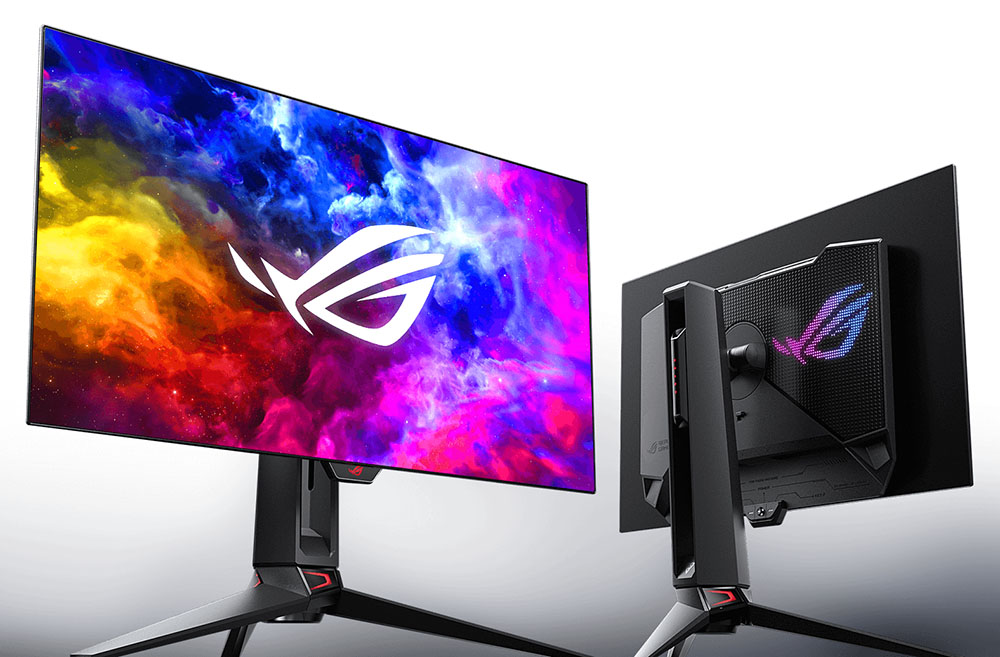
At around $1,000 to start, the Asus ROG Swift PG27AQDM is a premium purchase. But it also offers something no LCD can – infinite contrast. That’s not just a buzzword; I truly can’t measure an OLED panel’s black levels. When the pixels are off, they’re off. And unlike a Mini LED, every pixel can be modulated. Where a Mini LED has at most 1,152 dimming zones, a QHD OLED has 3,686,400. Which one do you think will look better?
Asus doesn’t stop there though. The color gamut is wider than all but a few panels I’ve tested, almost 97% of DCI-P3. And that color is spot-on and accurate with no need for calibration. My adjustment efforts only resulted in tiny measurement gains with no change in image quality.
The advantage of OLED video processing also cannot be understated. After testing many fast LCDs, I have observed that an OLED running at the same frame rate has visually superior motion resolution. Translation: moving objects are clearer. This is true both in test patterns and in real content. The PG27AQDM is one of the quickest monitors I’ve tested. And that includes comparisons to 360 and 500 Hz screens.
If you’re looking for the ultimate gaming monitor, it’s hard to imagine one better than the Asus ROG Swift PG27AQDM. Once you’ve tried it, you’ll want it.
MORE: Best Gaming Monitors
MORE: How We Test PC Monitors
!["[T]he First and Fifth Amendments Require ICE to Provide Information About the Whereabouts of a Detained Person"](https://images.inkl.com/s3/publisher/cover/212/reason-cover.png?w=600)






